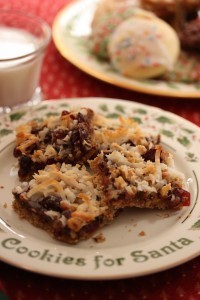Cookies and Layers
Well, it’s summertime (as you know), and I’m having a blast with my two littles. Which is, of course, what summer is all about. As I’m sure you also know, summer is also about cookies. Oh yes, indeedy, it is. And since summer is also about sharing (who knew summer was so awesome?), I’m sharing my favorite 7-Layer Cookie recipe below, followed by a popular post from the past. Originally, I published this post in the fall, when I made a connection between cooking soup and adding layers to a story. But it’s too freaking hot for soup. Hence the cookies. Enjoy!

Image Courtesy of Meal Makeover Moms @ Creative Commons
Ingredients:
1/2 cup margarine
1 cup graham cracker crumbs
1 cup flaked coconut
8 ounces peanut butter bits (some people use butterscotch bits, but I prefer peanut butter)
8 ounces chocolate chips
1/2 cup chopped nuts
1 can sweetened condensed milk
Directions: Melt margarine and put in a 13×9 pan. Sprinkle graham cracker crumbs over the margarine. Continue with the rest of the ingredients, sprinkling them one layer at a time, and finishing with the milk. Bake at 350º for 20-25 minutes.
So…what does this recipe have to do with writing a story? Well, the first draft of a story is usually pretty plain, like the graham cracker crust on this cookie. But once you start revising, you add the layers that flesh out the story and make it thicker, three-dimensional. There are a lot of things you could add to achieve this goal. Here are a few on my current revision list…
1. Subplots. These secondary plot lines add complexity and girth and are almost always directly tied-in to the main plot line. A romance that complicates the main character’s objective (The Hunger Games); a mystery that is solved at a pivotal point in the story (Saving Private Ryan); a friendship that spurs the mc on in her quest to reach her goal (Wither). Each subplot should have its own complete and smooth story arc. Keep this in mind when editing.
2. Theme. Some writers start with theme. Others figure it out along the way. Still others have the entire first draft done before they realize what the theme is (hello, me). However you do it, it’s crucial to at some point identify your story’s main theme so you can touch on it from start to finish. Think of your theme as a secondary subplot, one that needs a full arc from beginning to end. Revisit it frequently to add depth.
3. Character Renovations. Without fail, I get all the way through my first draft and realize that my main character is missing something. I hate that. But that’s what the revision process is for, no? To increase depth, add an endearing quirk, uncommon trait, or a fatal flaw to be overcome. For maximum impact, make the trait one that either helps or hinders the character’s ability to achieve his or her overall goal. For more information on fleshing out characters, definitely check out The Negative Trait Thesaurus and The Positive Trait Thesaurus on our Bookstore page.
4. Meaningful Repetitions. These include anything that is repeated throughout the story and, ideally, grows or changes with the story. Symbols and metaphors are good examples. Common phrases or sayings. Meaningful objects. Settings also apply: a favorite hang-out, the place your character goes when she needs downtime, a location that has specific significance or emotional importance. These repeated pieces are like touchstones for the reader, connecting them with the characters and embedding the reader more firmly into the story with each repetition.
What have I missed? What are some areas you like to focus on when adding layers to a story during the revision process?
The post Cookies and Layers appeared first on WRITERS HELPING WRITERS.
Writers Helping Writers
- Angela Ackerman's profile
- 1022 followers



